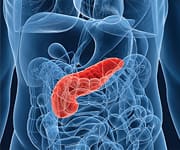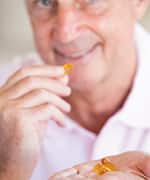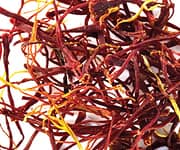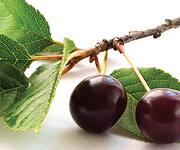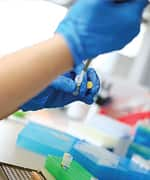Life Extension Magazine®
 | |
Mediterranean Diet Consumed in Middle Age Associated with Reduced Risk of Dying Over 6.8 Years of Follow-Up | |
| In an article published in the Journal of Nutrition, Spanish researchers report a significantly reduced risk of dying in association with greater adherence to a Mediterranean diet by middle-aged men and women.* Almudena Sanchez-Villegas and colleagues evaluated data from 15,535 Spanish university graduates who participated in the Seguimiento Universidad de Navarra Project, which began enrollment in 1999. Subjects in the current study had an average age of 38 and were free of cardiovascular disease, diabetes, or cancer upon enrollment. Dietary questionnaires completed at the beginning of the study and during follow-up were graded according to adherence to the Mediterranean diet. One hundred twenty-five deaths occurred between 1999 and 2010. Compared with participants who had low adherence to the diet, moderate adherence was associated with a 42% lower adjusted risk of dying and high adherence with a 62% lower risk. The Mediterranean diet is a high-fiber, heart-healthy eating plan where meals are centered around fruits, vegetables, and monounsaturated (good) fats like olive oil, nuts, and fish, with smaller amounts of meat and refined carbohydrates. Editor's Note: The authors suggest antioxidant and anti-inflammatory effects as well as prevention of endothelial damage as disease-protective mechanisms associated with high Mediterranean diet adherence. —D. Dye |
|
| Reference | |
| * J Nutr. 2012 Jul 18. | |
High Antioxidant Diet Could Lower Pancreatic Cancer Risk
Research described in an article published in the journal Gut reveals an association between higher levels of dietary antioxidants and a lower risk of cancer of the pancreas.* A team from the University of East Anglia and the University of Cambridge evaluated data from 23,658 participants in the EPIC-Norfolk study of men and women residing in Norfolk, England. Food diaries completed after enrollment provided data concerning the participants' intake of vitamins C, E, selenium, and zinc. Blood samples provided by 95% of the subjects were analyzed for serum vitamin C levels. Over the first decade of follow-up, 49 men and women developed cancer of the pancreas. Among participants whose combined intake of vitamins C, E, and selenium were among the top 75%, there was a 67% lower risk of developing pancreatic cancer compared to subjects whose intake was among the lowest 25%. Editor's Note: Authors Andrew R. Hart and colleagues remark that if the association is causal, 8.2% of all pancreatic cancers could be prevented by improved intake of selenium and vitamins C and E. —D. Dye | |
| Reference | |
| * Gut. 2012 Jul 24. | |
Reduced Vitamin D Levels Linked with Greater Risk of Dying Over 12-Year Period Among Frail Older Adults | |
In an article published in the European Journal of Clinical Nutrition, Ellen Smit and her associates report an increased risk of dying over a 12-year period among frail older men and women with reduced levels of vitamin D compared to those with higher levels.* The study included 4,731 participants who were over the age of 60. Among those whose vitamin D levels were among the lowest 25% of participants, there was a 94% greater risk of being frail compared to those whose levels were highest. Over a median 12.6 years of follow-up, subjects who were frail had more than twice the risk of dying than non-frail participants. Those who suffered from both frailty and low vitamin D levels had three times the risk of mortality compared to those who were not frail and whose vitamin D levels were high. Editor's Note: Frailty was defined as meeting three of five criteria that included low body mass index, slow gait, weakness, exhaustion, and reduced physical activity levels. Intermediate levels of vitamin D were associated with pre-frailty, defined as having one to two frailty factors. —D. Dye | |
| Reference | |
| * Eur J Clin Nutr. 2012 Jun 13. | |
Higher Vitamin B1 and B6 Status Linked with Lower Risk of Dying Over Eight-Year Period | |
| The journal Clinical Nutrition published the finding of an association between higher intake of vitamins B1 and B6, as well as higher plasma levels of pyridoxal-phosphate (an indicator of vitamin B6 status), with a lower risk of dying among older men and women during up to ten years of follow-up.* The study included 1,747 subjects who participated in the Taiwanese Elderly Nutrition and Health Survey from 1999 to 2000. The participants were followed through 2008, during which 627 men and women died. Subjects whose intake of vitamin B1 or vitamin B6 was among the top one-third of participants had a 26% lower adjusted risk of dying over follow-up compared to those whose intake was among the lowest third. Having an adequate pyridoxal phosphate level resulted in a 48% lower risk of dying than that experienced by those with deficient levels. Editor's Note: Vitamin B1 has particular relevance to muscle, blood, cardiovascular, and neurologic functions, and higher vitamin B6 intake and plasma concentrations may reduce elevated homocysteine levels, thereby lowering the risk of premature death due to conditions associated with hyperhomocysteinemia. —D. Dye | |
| Reference | |
| * Clin Nutr. 2012 Aug;31(4):448-54. | |
Coenzyme Q10 Plus Selenium Supplementation Reduces Cardiovascular Deaths in Trial | |
A four-year trial of CoQ10 and selenium has revealed a significant reduction in the risk of dying from cardiovascular disease among supplemented men and women.* The study, which was reported in the International Journal of Cardiology, also uncovered a reduction in the cardiac N-terminal proBNP (NT-proBNP), a biomarker of cardiomyocyte wall tension, which is elevated in congestive heart failure and left ventricular dysfunction. In a double-blinded trial, 228 Swedish citizens received a placebo or 200 micrograms of selenium per day plus 100 milligrams of CoQ10 twice daily for 48 months. Over 5.2 years of follow-up (which included the four-year treatment period), 5.9% of the supplemented group and 12.6% of the placebo group died of cardiovascular causes, which indicated a 54% adjusted risk reduction. Those in the treatment group also had lower levels of NT-proBNP compared to placebo, and better cardiac function as determined by echocardiography. Editor's Note: Authors Urban Alehagen and colleagues remark that selenium is essential for the optimal activity of TrxR1, a protein necessary for the effectiveness of CoQ10, which, in turn, is active in several metabolic pathways in the heart. Thus, having insufficient levels of either nutrient increases the risk of cardiovascular events. —D. Dye | |
| Reference | |
| * Int J Cardiol. 2012 May 22. | |
Supplementation with Curcumin Prevents Progression to Diabetes Among Prediabetics | |
| Supplementing with curcumin extract may help protect against the development of type II diabetes among men and women with prediabetes, according to the findings of a trial published in Diabetes Care.* Two hundred thirty-seven individuals with prediabetes were randomized to receive a daily regimen of three curcumin capsules containing 240 milligrams of curcuminoids each twice per day or placebo capsules for nine months. Physical examinations conducted upon enrollment and at three, six, and nine months provided data on body weight, waist circumference, glucose tolerance, insulin resistance, glycated hemoglobin, C-peptide, and other factors. At the end of the trial, 16.4% of the participants who received a placebo had developed diabetes. Among those who received curcumin, NO cases of diabetes occurred. The curcumin group had better functioning of beta-cells (cells of the pancreas that store and release insulin and C-peptide), decreased insulin resistance and higher adiponectin levels compared to the placebo group. Editor's Note: Authors Somlak Cheungsamarn and colleagues suggest that curcumin may prevent the progression of prediabetes to diabetes by maintaining healthy beta-cell function. They also noted that the increase in adiponectin observed in association with curcumin supplementation helps lower inflammation, which is a cause of beta-cell degradation. —D. Dye | |
| Reference | |
| * Diabetes Care. 2012 Jul 6. | |
Persian Saffron May Help Cure MS | |
A recent article published in the Journal of Immunology by a group of medical researchers at the University of Alberta have found that an active ingredient in the Persian spice saffron may be used to treat diseases involving neuroinflammation, such as multiple sclerosis.* In experiments conducted by the Alberta scientists, the use of a compound called crocin suppressed both inflammation and certain cell stresses, resulting in decreased neurological impairment in lab models and cell cultures with MS. "We found there is a compound in saffron, known as crocin, that exerts a protective effect in brain cell cultures and other models of MS. It prevented damage to cells that make myelin in the brain," said researcher Chris Power of the University. He noted that they are not close to clinical trials, but the results thus far are exciting. —M. Richmond | |
| Reference | |
| * Available at: http://www.research.ualberta.ca/en/VP%20Research%20News/2011/11/Saffronandmultiplesclerosis.aspx. Accessed August 25, 2012. | |
Vitamin B6 May Reduce Risk of Certain Breast Cancers | |
Scientists at the Cancer Epidemiology Program, University of Hawaii Cancer Center, recently examined the association of prediagnostic plasma concentrations of pyridoxal-5'-phosphate (PLP), an active form of vitamin B6, with postmenopausal breast cancer risk in a case-control study nested in the Multiethnic Cohort in Hawaii and Southern California.* After examining over 700 cases, along with over 700 similarly matched controls, scientists concluded that the data suggests higher circulating levels of vitamin B6 are associated with a reduced risk of invasive postmenopausal breast cancer. In fact, women with plasma PLP concentrations in the highest quartile had a 30% reduced risk of invasive breast cancer compared to the women in the lowest PLP quartile. When combined with further information from two other prospective studies, the group determined that there may be a role for vitamin B6 in breast cancer prevention. —M. Richmond | |
| Reference | |
| * Cancer Epidemiol Biomarkers Prev. 2012 Aug 9. | |
Berries: A Valuable Weapon Against Parkinson's | |
A recent article in the journal Neurology examined whether higher intakes of total flavonoids and their subclasses (flavanones, anthocyanins, flavan-3-ols, flavonols, flavones, and polymers) were associated with a lower risk of developing Parkinson's disease (PD).* In the analysis, scientists included 49,281 men in the Health Professional Follow-up Study and 80,336 women from the Nurses' Health Study. Five major sources of flavonoid-rich foods (tea, berry fruits, apples, red wine, and orange/orange juice) were also examined. Flavonoid intake was assessed using an updated food composition database and a validated food frequency questionnaire. In men, after adjusting for multiple confounders, participants in the highest quintile of total flavonoids had a 40% lower PD risk than those in the lowest quintile. This led scientists to conclude that intake of some flavonoids may reduce PD risk, particularly in men, but a protective effect of other constituents of plant foods cannot be excluded. Editor's Note: Life Extension® has long touted the benefits of berries in a longevity-centered diet. Life Extension®'s Berry Complete supplement is an excellent way to make sure you consume the proper amount of brain-protecting benefits from berries. —M. Richmond | |
| Reference | |
| * Available at: http://www.neurology.org/content/early/2012/04/04/wnl.0b013e31824f7fc4.short?rss=1. Accessed August 20, 2012. | |
Improperly Cooked Red Meat May Affect Cancer Risk | |
Life Extension® has been sounding the alarm on the dangers of over-cooked meat for years. A group of scientists from the University of Southern California, Norris Comprehensive Cancer Center, Keck School of Medicine conducted a study that once again confirms our position. The study, led by Mariana Stern, investigated the association between red meat and poultry intake and localized and advanced prostate cancer risk factor (PCA) taking into account cooking practices and polymorphisms in enzymes that metabolize carcinogens that accumulate in cooked meats.* In an interview done by Molly Rugg with Stern for USC's Keck School of Medicine website, Stern stated that, "We found that men who ate more than 1.5 servings of pan-fried red meat per week increased their risk of advanced prostate cancer by 30%. In addition, men who ate more than 2.5 servings of red meat cooked at high temperatures were 40% more likely to have advanced prostate cancer." —M. Richmond | |
| Reference | |
| * Available at: http://carcin.oxfordjournals.org/content/early/2012/07/13/carcin.bgs242.abstract. Accessed August 20, 2012. | |
Multi-Modal Therapies Show Promise in Treating Breast Cancer | |
A recent study published in the New England Journal of Medicine showed that a combination of anastrazole (Arimidex®) and fulvestrant (Faslodex®) improved the overall survival and progression-free survival in women with certain hormone-receptor positive metastatic breast cancers.* In order to study the drugs being used together, the team of scientists ran a trial involving 694 women who were randomly assigned a dose of Arimidex® alone or Arimidex® and Faslodex®. The scientists concluded that, "The combination of anastrozole and fulvestrant was superior to anastrozole alone or sequential anastrozole and fulvestrant for the treatment of HR-positive metastatic breast cancer, despite the use of a dose of fulvestrant that was below the current standard." Editor's Note: The aromatase inhibitor drug anastrazole dramatically reduces estrogen levels. Some women cannot tolerate estrogen deprivation, but for those with estrogen receptor positive breast tumors, anastrazole significantly improves survival. —M. Richmond | |
| Reference | |
| * Available at: http://www.nejm.org/doi/full/10.1056/NEJMoa1201622. Accessed August 18, 2012. |


